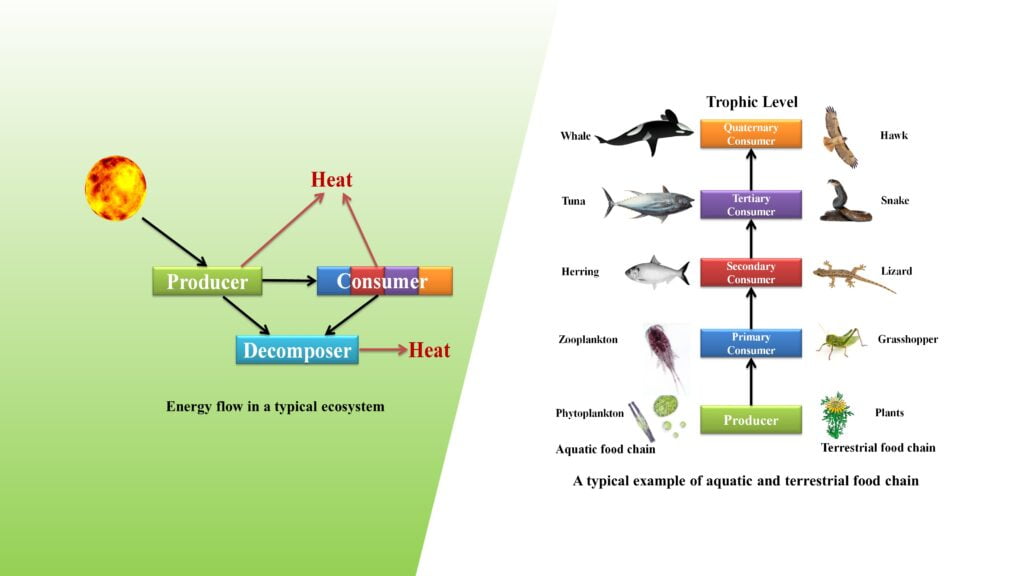
COMPETITIVE EXAM MCQs SERIES of ENVIRONMENTAL SCIENCE for UGC-NET/JRF, SLET, ARS, GATE, and other entrance tests – Environmental Biology: Ecosystem Structure and Functions.
Syllabus Outline
- Definition and components of ecosystems.
- Diverse roles of biotic and abiotic factors.
- Classification of terrestrial and aquatic ecosystems.
- Roles of producers, consumers, and decomposers within trophic levels.
- Food chains, food webs, and ecological pyramids.
- The flow of energy through ecosystems and nutrient cycling through biogeochemical cycles.
- The concept of ecological succession (e.g. primary and secondary).
- Climax communities and the impact of disturbances.
- Ecosystem services and their changes due to environmental issues (e.g. climate change, biodiversity loss, and pollution).
- Application of ecology in agriculture, forestry, fisheries, restoration, reforestation, and urban ecology.
This quiz contains the concept-based most frequently asked 25 MCQs of “Environmental Biology – Ecosystem Structure and Functions“. Each question has a single correct/most appropriate answer.
*****
1. A researcher conducts a long-term study on a grassland ecosystem and observes an increase in plant diversity over time. What ecological concept might explain this phenomenon?
a) Ecological succession
b) Biotic homogenization
c) Facilitation
d) Competitive exclusion
2. The concept of ecological niche includes:
I. Physical location of an organism
II. Role of an organism in an ecosystem
III. Function of an organism in an ecosystem
IV. Interaction of an organism with biotic factors
V. Interaction of an organism with abiotic factors
a) I, II, III and IV
b) I, II, III, IV and V
c) I, II and III
d) I
3. A long-term ecological study tracks changes in bird migration patterns over several decades. What term describes such studies on patterns and trends over extended periods?
a) Paleoecological investigation
b) Cross-sectional study
c) Retrospective analysis
d) Longitudinal study
4. Researchers conduct a meta-analysis of multiple studies investigating the relationship between biodiversity and ecosystem stability. What conclusion is often drawn from such analyses?
a) Biodiversity and stability show a random relationship
b) Ecosystem stability decreases with increasing biodiversity
c) Biodiversity has a negligible impact on ecosystem stability
d) High biodiversity consistently enhances ecosystem stability
5. A study examines the impact of deforestation on carbon sequestration in a tropical rainforest. What role do soil microorganisms play in this process?
a) Facilitating carbon decomposition and storage in soil
b) Accelerating carbon release
c) Storing carbon in plant biomass
d) Enhancing carbon uptake by vegetation
6. In an alpine ecosystem, researchers find that plant diversity increases with elevation up to a certain point, after which it declines. What term is often used to describe this pattern?
a) Mid-domain effect
b) Species packing
c) Altitudinal succession
d) Elevational zonation
7. In an experimental study examining nutrient cycling, if phosphorus levels are manipulated in a freshwater ecosystem, what potential impact could it have on algal growth?
a) Unchanged algal growth as phosphorus has no effect
b) Decreased algal growth due to phosphorus enrichment
c) Shift from nitrogen to phosphorus limitation affecting algal growth
d) Increased algal growth due to phosphorus limitation
8. How does the presence of biodiversity contribute to ecosystem resistance to invasive species?
a) High biodiversity enhances the invasiveness of non-native species
b) High biodiversity provides a greater variety of niches, making invasion more difficult
c) Biodiversity has no impact on the resistance to invasive species
d) Invasive species thrive in ecosystems with low biodiversity
9. Which factor contributes to the resilience of an ecosystem, allowing it to recover from disturbances?
a) Presence of invasive species
b) High anthropogenic impact
c) Low species diversity
d) High species diversity
10. What role do keystone species play in maintaining ecosystem stability?
a) They have a disproportionately large impact on ecosystem structure and function
b) They are invasive species that disrupt ecosystem balance
c) They are dominant species that control the population of all other species
d) They contribute to high species diversity
11. A researcher discovers a new plant species with unique biochemical properties. What is the potential value of this discovery in the context of ecosystem services?
a) Cultural value
b) Aesthetic value
c) Medicinal value
d) Provisioning value
12. Research suggests that apex predator loss, such as wolves, can increase herbivore populations, influencing plant communities. This phenomenon is known as:
a) Herbivore amplification
b) Trophic downgrading
c) Ecological rewilding
d) Predator-prey dynamics
13. Which would be considered a regulating service of ecosystems?
a) Soil fertility improvement by leguminous plants
b) Water purification by wetlands
c) Crop pollination by bees
d) Timber production from a forest
14. How does the process of biological magnification impact higher trophic levels in an ecosystem?
a) It causes the accumulation of pollutants in organisms
b) It promotes the stability of ecosystems
c) It leads to a decrease in predator-prey interactions
d) It increases biodiversity
15. If a top predator removal increases the population of herbivores and a subsequent decrease in plant biomass, what term is used to describe this phenomenon?
a) Top-down cascade
b) Bottom-up cascade
c) Trophic amplification
d) Ecosystem reorganization
16. What is the role of trophic cascades in regulating herbivore populations in ecosystems?
a) Trophic cascades only occur in aquatic ecosystems
b) Predators indirectly control herbivore populations by influencing the abundance of plant species
c) Herbivores directly control the populations of predators
d) Herbivores and predators have independent effects on plant communities
17. What is the significance of the trophic level efficiency in understanding energy transfer within ecosystems?
a) It measures the total biomass at each trophic level
b) It quantifies the percentage of energy transferred between trophic levels
c) It determines the reproductive rates of different trophic levels
d) It assesses the genetic diversity within trophic levels
18. Which vegetation can play a significant role in storing carbon in soil?
a) Deciduous trees
b) Deep-rooted perennials
c) Annual grasses
d) Evergreen shrubs
19. What does the term trophic cascade refer to in ecological modelling?
a) Flow of energy through trophic levels
b) Impact of predators on prey populations
c) Top-down regulation of an ecosystem
d) Bottom-up regulation of an ecosystem
20. Which hypothesis proposes that more diverse ecosystems can easily resist and recover from disturbances?
a) Intermediate Disturbance Hypothesis
b) Biodiversity Resilience Hypothesis
c) Redundancy Hypothesis
d) Insurance Hypothesis
21. How does the concept of ecotones contribute to understanding ecosystem boundaries?
a) Ecotones are transitional areas between different ecosystems
b) Ecotones only occur in aquatic ecosystems
c) Ecotones define the climax community of an ecosystem
d) Ecotones represent zones of high biodiversity
22. If the connectivity between breeding and wintering grounds is disrupted, what effect might be on migratory bird populations?
a) Increased risk of local extinction
b) Decreased population size due to limited resource availability
c) Altered migration routes affecting population dynamics
d) Increased population size due to enhanced breeding success
23. In an ecological modelling study, researchers use mathematical models to simulate the effects of varying predation rates on herbivore populations in a savanna ecosystem. What type of model is being employed?
a) Empirical model
b) Stochastic model
c) Population dynamics model
d) Simulation model
24. A researcher is studying the impact of climate change on ecosystems and observes a shift in the distribution of plant and animal species towards higher elevations or latitudes. What is this phenomenon called?
a) Ecosystem succession
b) Biogeographic shift
c) Ecological niche expansion
d) Range shift
25. In a study examining the impact of invasive species on native biodiversity, what role might competitive exclusion play in shaping community dynamics?
a) Promoting coexistence between invasive and native species
b) Facilitating invasion through mutualistic interactions
c) Limiting the establishment of invasive species
d) Fostering niche partitioning among native species
*****
Previous: Origin of life and speciation
Next: Ecological Succession and Species Diversity
References
- Odum, Eugene P. (1993) Ecology and Our Endangered Life-Support Systems, Sinauer Associates Inc., 3rd edition.
- Singh, R. B., and Sinha, R. K. (2017) Environmental Science: Earth as a Living Planet, Khanna Publishers, 1st edition.
- Sharma, P. D., and Jha, R. (2017) Environmental Biology, Rastogi Publications, 1st edition.

